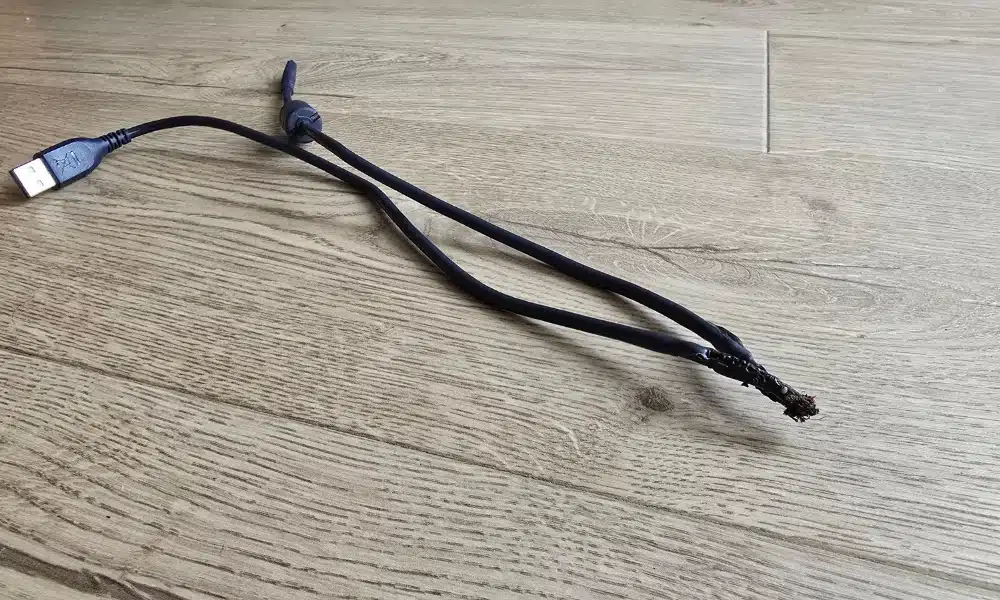It’s one of those moments that makes your heart drop.
This morning, my kids plugged in their gaming console before heading off to school. Nothing unusual. This afternoon, I caught a whiff of something odd – the unmistakeable smell of burning plastic.
After a frantic search, I found the culprit: the USB cable charging the console had caught fire. It had melted onto the leather couch but, thankfully, hadn’t spread. The console, packed with a lithium battery, stayed intact, which was extremely lucky. A lithium fire can be devastating and almost impossible to extinguish.
The experience rattled me. It also reminded me how often we leave things charging, running, or simply switched on at the wall without a second thought.
The hidden dangers lurking in your lounge room
In Australia, electrical faults cause more than 40% of residential fires every year, according to Fire and Rescue NSW1. That’s thousands of homes at risk simply because of overlooked or ageing appliances, dodgy cords, overloaded power boards, or devices left charging.
The rise of household electronics hasn’t helped either. On average, Aussies own over 17 connected devices per household2. That’s a lot of cords, batteries and chargers, and a lot of potential ignition points.
And it’s not just phones and game consoles. E-bikes, e-scooters and other lithium battery-powered gadgets have become everyday essentials. But with that convenience comes new risks.
Lithium battery fires, in particular, are no joke. These batteries can ignite spontaneously if damaged, overcharged or exposed to heat. Worse still, once a lithium battery fire starts, it burns extremely hot and fast, often releasing toxic gases.

Why switching off at the wall matters
You might think, “It’s just on standby, it’s fine.” But even appliances on standby draw power, and any faulty wiring, cheap charger, or poorly ventilated device can turn into a fire hazard without warning.
Here’s the kicker: simply switching off at the wall reduces the risk significantly. It cuts the power supply completely, stopping overheating, short circuits and battery failures before they start.
It also saves you money. Standby power accounts for up to 10% of the average Australian electricity bill3. So, by flicking that switch, you’re protecting your home and your hip pocket.
Charging safely: it’s not just common sense, it’s survival
Charging safely isn’t about being paranoid. It’s about giving your devices (and yourself) the best chance of avoiding disaster.
A few quick tips to keep your home safe:
- Use quality chargers and cables: Always use manufacturer-approved gear. Cheap knock-offs can overheat and fail.
- Avoid charging unattended: Charge when you’re home and awake. Don’t leave devices charging overnight or while you’re out.
- Keep chargers ventilated: Don’t tuck chargers under pillows, behind couches or inside drawers where heat can build up.
- Don’t overload power boards: One bad connection can spark a chain reaction.
- Inspect cords and devices regularly: Frayed wires, bulging batteries and loose connections are ticking time bombs.
- Charge e-bikes and scooters with care: Always in a ventilated, fire-resistant area – preferably not indoors if you can help it.
And remember, unplugging is even safer than switching off.
The scary reality of e-bike and e-scooter fires
As much as we love our electric rides, they have made headlines for all the wrong reasons. NSW Fire and Rescue reported over 180 lithium battery fires across the state in 2023 alone4.
Many of these incidents involved e-bikes and e-scooters charging unsupervised, often overnight. These fires aren’t just fast – they can be deadly, producing explosive flames and toxic smoke within seconds.
Some advice for e-bike and scooter users:
- Stick to certified brands: Avoid aftermarket or dodgy online batteries.
- Replace damaged batteries immediately: If it’s bent, cracked or dented, it’s dangerous.
- Never modify your battery or charger: DIY repairs are a recipe for disaster.
- Charge outside if possible: Or in a garage with a smoke alarm.
A simple switch for peace of mind
I keep thinking: if I’d gone out today instead of staying home, the outcome could have been catastrophic. Our home, our memories – gone, because of a simple USB cable. I’ll also remember to thank my husband who persuaded me to get a leather couch. Had we gone with my choice, a fabric couch, I might be writing a very different blog right now.
Switching off at the wall isn’t just something your nan nags you about. It’s a simple, powerful habit that could save your home – and maybe even your life.
So next time you walk past that socket, remember: flick it off. You’ll sleep better for it.


















